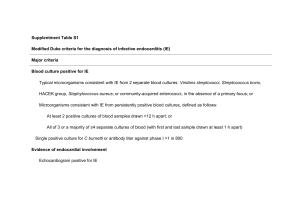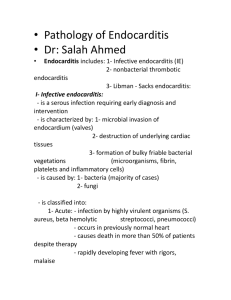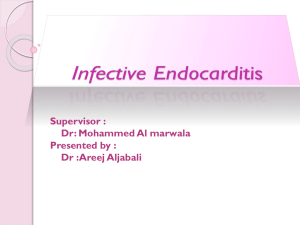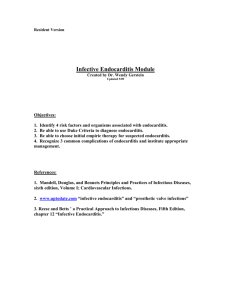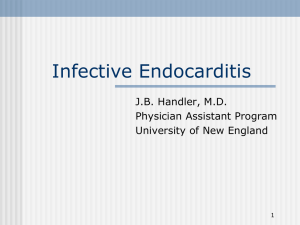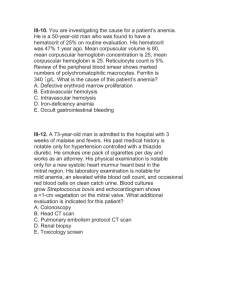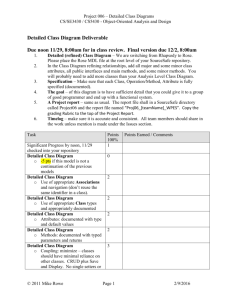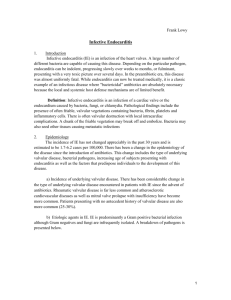Endocarditis
advertisement
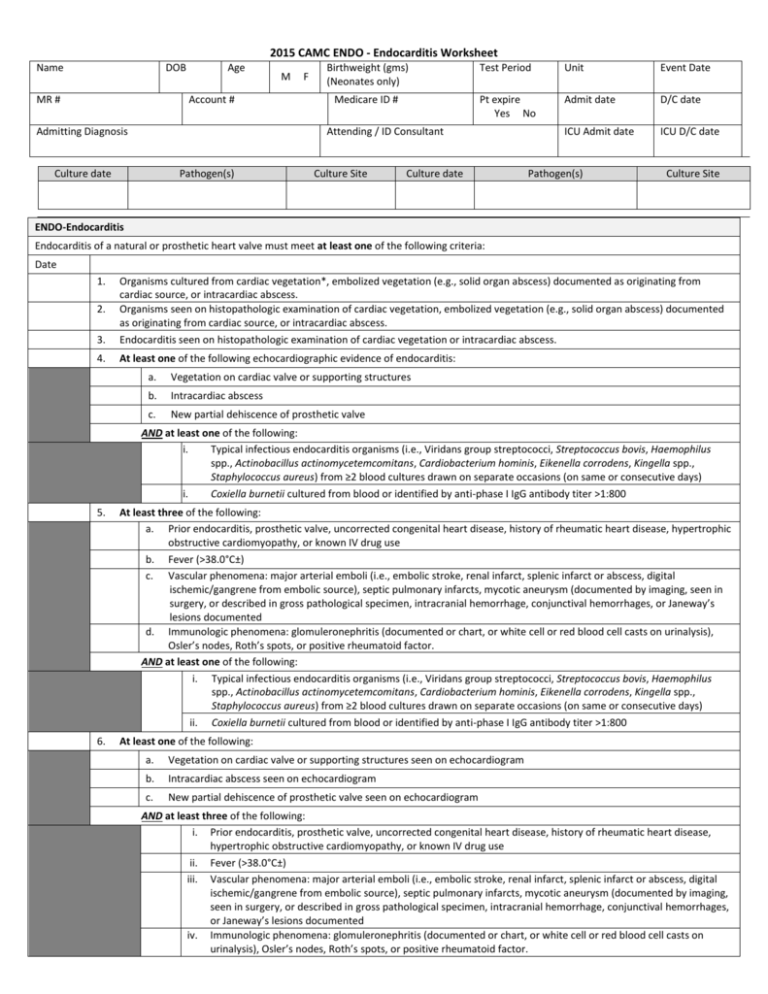
2015 CAMC ENDO - Endocarditis Worksheet Name DOB MR # Age Account # Admitting Diagnosis M F Birthweight (gms) (Neonates only) Test Period Unit Event Date Medicare ID # Pt expire Yes No Admit date D/C date ICU Admit date ICU D/C date Attending / ID Consultant Culture date Pathogen(s) Culture Site Culture date Pathogen(s) Culture Site ENDO-Endocarditis Endocarditis of a natural or prosthetic heart valve must meet at least one of the following criteria: Date 1. 3. Organisms cultured from cardiac vegetation*, embolized vegetation (e.g., solid organ abscess) documented as originating from cardiac source, or intracardiac abscess. Organisms seen on histopathologic examination of cardiac vegetation, embolized vegetation (e.g., solid organ abscess) documented as originating from cardiac source, or intracardiac abscess. Endocarditis seen on histopathologic examination of cardiac vegetation or intracardiac abscess. 4. At least one of the following echocardiographic evidence of endocarditis: 2. a. Vegetation on cardiac valve or supporting structures b. Intracardiac abscess c. New partial dehiscence of prosthetic valve AND at least one of the following: i. Typical infectious endocarditis organisms (i.e., Viridans group streptococci, Streptococcus bovis, Haemophilus spp., Actinobacillus actinomycetemcomitans, Cardiobacterium hominis, Eikenella corrodens, Kingella spp., Staphylococcus aureus) from ≥2 blood cultures drawn on separate occasions (on same or consecutive days) ii. Coxiella burnetii cultured from blood or identified by anti-phase I IgG antibody titer >1:800 5. At least three of the following: a. Prior endocarditis, prosthetic valve, uncorrected congenital heart disease, history of rheumatic heart disease, hypertrophic obstructive cardiomyopathy, or known IV drug use b. Fever (>38.0°C±) c. Vascular phenomena: major arterial emboli (i.e., embolic stroke, renal infarct, splenic infarct or abscess, digital ischemic/gangrene from embolic source), septic pulmonary infarcts, mycotic aneurysm (documented by imaging, seen in surgery, or described in gross pathological specimen, intracranial hemorrhage, conjunctival hemorrhages, or Janeway’s lesions documented d. Immunologic phenomena: glomuleronephritis (documented or chart, or white cell or red blood cell casts on urinalysis), Osler’s nodes, Roth’s spots, or positive rheumatoid factor. AND at least one of the following: i. Typical infectious endocarditis organisms (i.e., Viridans group streptococci, Streptococcus bovis, Haemophilus spp., Actinobacillus actinomycetemcomitans, Cardiobacterium hominis, Eikenella corrodens, Kingella spp., Staphylococcus aureus) from ≥2 blood cultures drawn on separate occasions (on same or consecutive days) ii. Coxiella burnetii cultured from blood or identified by anti-phase I IgG antibody titer >1:800 6. At least one of the following: a. Vegetation on cardiac valve or supporting structures seen on echocardiogram b. Intracardiac abscess seen on echocardiogram c. New partial dehiscence of prosthetic valve seen on echocardiogram AND at least three of the following: i. Prior endocarditis, prosthetic valve, uncorrected congenital heart disease, history of rheumatic heart disease, hypertrophic obstructive cardiomyopathy, or known IV drug use ii. Fever (>38.0°C±) iii. Vascular phenomena: major arterial emboli (i.e., embolic stroke, renal infarct, splenic infarct or abscess, digital ischemic/gangrene from embolic source), septic pulmonary infarcts, mycotic aneurysm (documented by imaging, seen in surgery, or described in gross pathological specimen, intracranial hemorrhage, conjunctival hemorrhages, or Janeway’s lesions documented iv. Immunologic phenomena: glomuleronephritis (documented or chart, or white cell or red blood cell casts on urinalysis), Osler’s nodes, Roth’s spots, or positive rheumatoid factor. 2015 CAMC ENDO - Endocarditis Worksheet v. Identification of an organism from the blood by at least one of the following methods: Recognized pathogen cultured from one or more blood cultures, Same common commensal organism cultured from ≥2 blood cultures drawn on separate occasions (on same or consecutive days), or Organism identified by non-culture diagnostic test from blood (e.g., serology, PCR) 7. All of the following criteria: a. Prior endocarditis, prosthetic valve, uncorrected congenital heart disease, history of rheumatic heart disease, hypertrophic obstructive cardiomyopathy, or known IV drug use b. Fever (>38.0°C±) c. Vascular phenomena: major arterial emboli (i.e., embolic stroke, renal infarct, splenic infarct or abscess, digital ischemic/gangrene from embolic source), septic pulmonary infarcts, mycotic aneurysm (documented by imaging, seen in surgery, or described in gross pathological specimen, intracranial hemorrhage, conjunctival hemorrhages, or Janeway’s lesions documented d. Immunologic phenomena: glomuleronephritis (documented or chart, or white cell or red blood cell casts on urinalysis), Osler’s nodes, Roth’s spots, or positive rheumatoid factor. e. Identification of an organism from the blood by at least one of the following methods: recognized pathogen cultured from one or more blood cultures, same common commensal organism cultured from ≥2 blood cultures drawn on separate occasions (on same or consecutive days), or organism identified by non-culture diagnostic test from blood (e.g., serology, PCR) * With no other recognized cause ± As documented in the medical record Reporting instruction “Cardiac vegetation” includes vegetation on a pacemaker/ defibrillator lead. Notes/Comments: 2015 CAMC ENDO - Endocarditis Worksheet Unit RIT Infection Window Period Date of Event Hospital Day Date Table of Events Infection Window Period (first + diagnostic test, 3 days before & 3 days after) Repeat Infection Timeframe-RIT (14 day timeframe where date of event = day 1) Date of Event (date the first element occurs for the first time within the infection window period) Secondary BSI Attribution Period (Infection Window Period + RIT)
